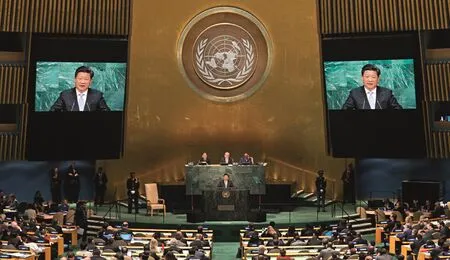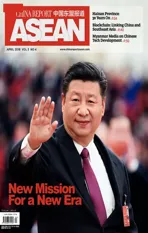VISION OF A BETTER WORLD
2018-04-14ByWangYiwei
By Wang Yiwei

Left: Addressing the general debate of the 70th sessionof the United Nations General Assembly at the UN headquarters in New York on September 28, 2015, PresidentXi Jinping introduced the concept of a community with a shared future for mankind.
During the recent annual“two sessions,” a constitutional amendment to add the concept of “building a community with a shared future for mankind” into China’s Constitution was passed by the National People’s Congress,the country’s top legislature.Following its inclusion into the Constitution of the Communist Party of China (CPC) during the 19th CPC National Congress last October, this vision has been reinforced as the will of the Party and the aspiration of the people, testifying to an organic integration of the Party’s leadership and the people’s interests that promotes lawbased governance.
Role of a Responsible Country
Throughout human history,any cooperative initiative or concept that guided world progress was proposed by a responsible major state. Today,the Belt and Road Initiative and the “community with a share future for mankind” vision driving it precisely represent such a historic mission. As the core concept of China’s new type of international relations and new model for global governance,the “community with a share future for mankind” concept represents a global outlook in alignment with Xi Jinping Thought on Socialism with Chinese Characteristics for a New Era and consistent with the CPC’s commitment to promoting the progress of mankind.
Xi Jinping Thought on Socialism with Chinese Characteristics for a New Era draws inspiration from 5,000-year-old Chinese civilization and embodies the Chinese nation’s long-cherished dream of modernization, which is heralding a new horizon for Marxism to be modernized and popularized in China—evidenced by the three keywords of“community with a share future for mankind”:
“Mankind” was chosen for the concept to connote modern improvements on Chinese traditional values and outlooks on the world. The Peace of Westphalia, a treaty signed in 1648 to end European wars of religion, established a new system of political order in central Europe. As its influence spread around the globe, the Westphalia principles helped promote stable world order but also led to certain unfairness.Tribalism persists in countries that lag behind in modern development, while “power logic”and “priority logic” constantly challenge global fairness and justice. With “mankind” in mind,President Xi Jinping presented a vision that transcends national boundaries and showcases the people-centric and world-for-all philosophies of Chinese culture.
“Shared future” represents China’s call for all nations to explore a development path that fits their own national conditions just as China has done over the past 180 years, as well as its hope to establish a global identity for future humanity that transcends ideology and values. This part exhibits the modernity and global responsibility of the Chinese civilization.
“Community” transcends national and cultural boundaries to seek common grounds throughout humanity at large and achieve a world-for-all for the era of globalization. It transcends regional integration and economic globalization in search of geographical, political and cultural fusions for all mankind.
These three elements combine to improve on the modern political civilization pioneered by the West and implement the“community of free individuals”concept of Marxism and the ideals of communism in the new era.
With “mankind” in mind, President Xi Jinping presented a vision that transcends national boundaries and showcases the people-centric and world-for-all philosophies of Chinese culture.
“Global Dream”
The “community with a shared future for mankind” concept is a “global dream” presented by Xi Jinping, also general secretary of the CPC Central Committee,following the “Chinese Dream.”While delivering a keynote speech at the CPC in Dialogue with World Political Parties High-Level Meeting in Beijing last December,Xi noted that the Belt and Road Initiative is an example of the practice of “building a community with a shared future for mankind.”
Since Xi stressed “a community with a shared future for mankind”at the 2017 annual meeting of the World Economic Forum in Davos,Switzerland, the phrase has been enshrined by the United Nations General Assembly, UN Security Council and other institutions into their resolutions, elevating the Chinese concept to international consensus. “Belt and Road” as well as “community with a shared future for mankind” have become key phrases highlighting China’s global influence and appeal in the new era.
The vision of a community with a shared future for mankind tightly aligns with two major global aspirations: peace and development. It aims to promote the common development of all nations while averting conflict.Each country is different, which makes the world diverse. But common historical memories,common situations and common pursuits keep countries closely linked, shaping common identities for a shared future.
The vision fuels the purposes and principles of the Charter of the United Nations. It is the core of the principle of wide consultation, joint contributions and shared benefits in global governance. It builds on the traditional saying that “Mankind has only one earth, and it is home to all countries” to create a more optimistic outlook: We have a stake in each other’s success and our futures are closely connected. As members of an intimate human community of shared future, we should come together to build a new human civilization—a world truly shared by all and benefiting all. The community of shared future transcends the narrow perspective of nation-states and contrasting interests. For the lasting and sustainable development of human civilization, it elevates a new type of international relations characterized by win-win cooperation and a more just and equitable international order.
Our home planet is facing increasingly frequent challenges.New drivers are needed for global economic growth, and development needs to be more inclusive and balanced to minimize the gap between rich and poor. Local turbulence and hotspot issues remain unavoidable, while terrorism continues spreading.Building a community with a shared future for mankind reflects the commitment of China—the world’s second largest economy,the largest emerging country and the largest developing country—to promoting global growth by improving relationships between developed countries, emerging countries and developing countries.
Constitutional enshrinement of the concept signals China’s resolve and confidence to build an open, inclusive, clean and beautiful world with lasting peace, universal security and common prosperity.
